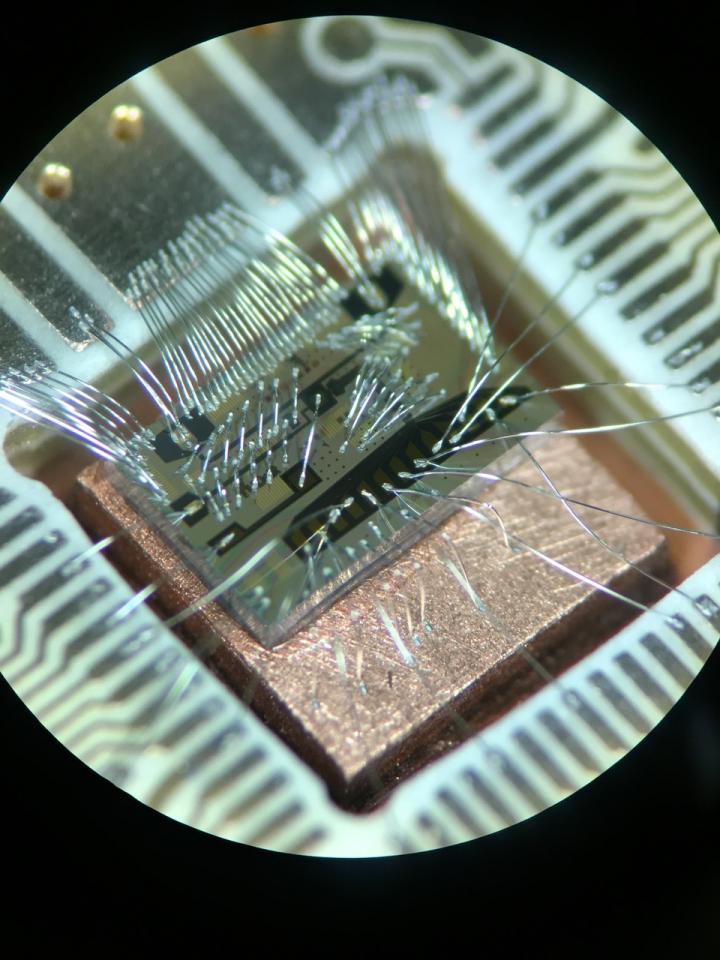Quantum race accelerates development of silicon quantum chip

The quantum computer of the future will be able to carry out computations far beyond the capacity of today's computers. Credit: TU Delft
The quantum computer of the future will be able to carry out computations far beyond the capacity of today's computers. Quantum superpositions and entanglement of quantum bits (qubits) make it possible to perform parallel computations. Scientists and companies worldwide are engaged in creating increasingly better quantum chips with more and more quantum bits. QuTech in Delft is working hard on several types of quantum chips.
Familiar material
The core of the quantum chips is made of silicon. “This is a material that we are very familiar with,” explains Professor Lieven Vandersypen of QuTech and the Kavli Institute of Nanoscience Delft, “Silicon is widely used in transistors and so can be found in all electronic devices.” But silicon is also a very promising material for quantum technology. PhD candidate Guoji Zheng: “We can use electrical fields to capture single electrons in silicon for use as quantum bits (qubits). This is an attractive material as it ensures the information in the qubit can be stored for a long time.”
Large systems
Making useful computations requires large numbers of qubits and it is this upscaling to large numbers that is providing a challenge worldwide. “To use a lot of qubits at the same time, they need to be connected to each other; there needs to be good communication”, explains researcher Nodar Samkharadze. At present the electrons that are captured as qubits in silicon can only make direct contact with their immediate neighbours. Nodar: “That makes it tricky to scale up to large numbers of qubits.”
Neck-and-neck race
Other quantum systems use photons for long-distance interactions. For years, this was also a major goal for silicon. Only in recent years have various scientists made progress on this. The Delft scientists have now shown that a single electron spin and a single photon can be coupled on a silicon chip. This coupling makes it possible in principle to transfer quantum information between a spin and a photon. Guoji Zheng: “This is important to connect distant quantum bits on a silicon chip, thereby paving the way to upscaling quantum bits on silicon chips.”
On to the next step
Vandersypen is proud of his team: “My team achieved this result in a relatively short time and under great pressure from worldwide competition.” It is a true Delft breakthrough: “The substrate is made in Delft, the chip created in the Delft cleanrooms, and all measurements carried out at QuTech,” adds Nodar Samkharadze. The scientists are now working hard on the next steps. Vandersypen: “The goal now is to transfer the information via a photon from on electron spin to another.”
###
This research was funded by an ERC Synergy Grant, NWO via the Nanofront Program and Intel.
In a separate study published in the same issue of Science today, other researchers from the Kavli institute of Nanoscience at TU Delft also found a way to transfer spin information to photons. Read the press release about this related research here.
Media Contact
All latest news from the category: Physics and Astronomy
This area deals with the fundamental laws and building blocks of nature and how they interact, the properties and the behavior of matter, and research into space and time and their structures.
innovations-report provides in-depth reports and articles on subjects such as astrophysics, laser technologies, nuclear, quantum, particle and solid-state physics, nanotechnologies, planetary research and findings (Mars, Venus) and developments related to the Hubble Telescope.
Newest articles

Superradiant atoms could push the boundaries of how precisely time can be measured
Superradiant atoms can help us measure time more precisely than ever. In a new study, researchers from the University of Copenhagen present a new method for measuring the time interval,…

Ion thermoelectric conversion devices for near room temperature
The electrode sheet of the thermoelectric device consists of ionic hydrogel, which is sandwiched between the electrodes to form, and the Prussian blue on the electrode undergoes a redox reaction…

Zap Energy achieves 37-million-degree temperatures in a compact device
New publication reports record electron temperatures for a small-scale, sheared-flow-stabilized Z-pinch fusion device. In the nine decades since humans first produced fusion reactions, only a few fusion technologies have demonstrated…





















